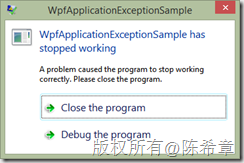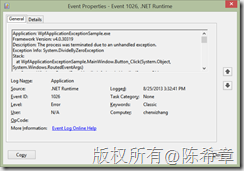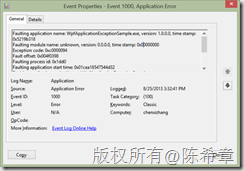首先,我们当然是要求应用程序开发人员,尽可能地在程序可能出现异常的地方都去捕捉异常,使用try…catch的方式。但是总是有一些意外的情况可能会发生,这就导致会出现所谓的“未捕获异常(UnhandledException)”。对于这一类异常,如果我们没有一个合适的策略进行处理,则当其发生的时候,会给用户带来不太好的使用体验。例如下面这样
备注:这个截图是在Windows 8上面做的,其他操作系统看到的界面可能略有不同。
用户看到这个窗口的时候,其实一般只能点击Close the prograrm按钮。也就是说,这种情况下会导致用户无法继续使用这个程序,而且他们还得不到任何具体的消息:到底发生了什么事情了?除非他们去查看Windows的事件日志。(但一般的用户是不太会这个操作的)
我们可以看到在Windows事件日志中,会有两个具体的事件。首先是一个.NET Runtime的事件
然后是一个Application Error的事件
通常来说,这样的用户体验有值得改进的地方。我们虽然不能防止异常的产生,但是当意外发生的时候,我们应该要以更好地方式地通知到用户,或者尽可能地不要影响用户当前的操作。
在WPF这种应用程序中,会有两大类未处理异常:一类是在UI线程抛出来的,例如点击了用户界面上面的某个控件,然后执行某个代码的时候,遇到了异常;另一类是非UI线程跑出来的,例如在一个多线程的程序里面,工作线程的代码遇到了异常。
对于UI线程的未处理异常,我们可以通过监控下面这个事件来处理:Application.Current.DispatcherUnhandledException
http://msdn.microsoft.com/en-us/library/system.windows.application.dispatcherunhandledexception.aspx
一个参考代码如下:
using System; using System.Windows; namespace WpfApplicationExceptionSample { /// <summary> /// Interaction logic for App.xaml /// </summary> public partial class App : Application { public App() { Application.Current.DispatcherUnhandledException += Current_DispatcherUnhandledException; } void Current_DispatcherUnhandledException(object sender, System.Windows.Threading.DispatcherUnhandledExceptionEventArgs e) { MessageBox.Show("我们很抱歉,当前应用程序遇到一些问题,该操作已经终止,请进行重试,如果问题继续存在,请联系管理员.", "意外的操作", MessageBoxButton.OK, MessageBoxImage.Information);//这里通常需要给用户一些较为友好的提示,并且后续可能的操作 e.Handled = true;//使用这一行代码告诉运行时,该异常被处理了,不再作为UnhandledException抛出了。 } } }
运行的效果大致如下
对于非UI线程抛出的未处理异常,我们需要监控另外一个事件来处理:AppDomain.CurrentDomain.UnhandledException。
http://msdn.microsoft.com/en-us/library/system.appdomain.unhandledexception.aspx
一个参考代码如下
using System; using System.Windows; namespace WpfApplicationExceptionSample { /// <summary> /// Interaction logic for App.xaml /// </summary> public partial class App : Application { public App() { AppDomain.CurrentDomain.UnhandledException += CurrentDomain_UnhandledException; } void CurrentDomain_UnhandledException(object sender, UnhandledExceptionEventArgs e) { MessageBox.Show("我们很抱歉,当前应用程序遇到一些问题,该操作已经终止,请进行重试,如果问题继续存在,请联系管理员.", "意外的操作", MessageBoxButton.OK, MessageBoxImage.Information); } } }
令人不解的是,这个事件中没有和前面那个事件一样的e.Handled参数,就是说,虽然这样是可以捕捉到非UI线程的异常,而且也可以进行相应的处理,但是应用程序还是会退出,也就是说这个异常还是被当作是未处理异常继续汇报给Runtime。
为了改进这一点,我们可以通过修改配置文件来实现。
<?xml version="1.0" encoding="utf-8" ?> <configuration> <runtime> <legacyUnhandledExceptionPolicy enabled="1"/> </runtime> <startup> <supportedRuntime version="v4.0" sku=".NETFramework,Version=v4.5" /> </startup> </configuration>
这里的legacyUnhandledExceptionPolicy,如果enabled=1的话,用意是使用早期版本的异常处理策略。




